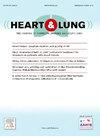重症监护病房出院后创伤后应激症状与希望之间的关系:一项纵向队列研究的结果
IF 2.4
4区 医学
Q2 CARDIAC & CARDIOVASCULAR SYSTEMS
引用次数: 0
摘要
背景:希望对于一般的心理健康和严重疾病后的康复至关重要。然而,在重症监护病房(ICU)幸存者中,创伤后应激症状(PTSS)与希望之间的关系尚未被调查。目的:评估ICU患者入院后3、6和12个月的希望,并检查希望与选定的人口统计数据、临床特征和ICU患者3个月后应激障碍水平之间的可能关联。方法:采用Herth希望指数对挪威icu患者进行自我报告。人口统计学和临床特征数据是从患者报告和医疗记录中收集的。采用描述性统计和线性混合模型回归分析入院后3个月的ptsd。结果:共纳入73例成人ICU存活患者,其中男性45例(61.6%);中位年龄66岁[IQR: 51.0;74.0])。在3个月、6个月和12个月时,希望得分中位数分别为41、40和42。在6个月时,临床较少但统计学意义显著的希望减少(B = -1.24;95%置信区间[CI]: -2.25, -0.23;P = 0.016)。入院后3个月ptsd水平较低(B = -0.13;95% ci [-0.23, -0.03];p = 0.015),入学前已就业(B = 5.87;95% ci [1.85, 9.88];P = 0.004)与入院后第一年的较高希望显著相关。更高的希望与更长的住院时间之间也存在较小但具有统计学意义的关联(B = 0.08;95% ci [0.00, 0.15];P = 0.042)。结论:希望评分在ICU入院后第一年保持稳定。入院后3个月ptsd水平较低、入院前有工作、住院时间较长与入院后第一年的希望较高相关。鉴于样本量小,需要在更大的样本量中进行更多的研究,以增强这些发现的临床相关性。本文章由计算机程序翻译,如有差异,请以英文原文为准。
The association between posttraumatic stress symptoms and hope following intensive care unit discharge: Findings from a longitudinal cohort study
Background
Hope is essential for mental health in general and for recovery following severe illness. However, the associations between posttraumatic stress symptoms (PTSS) and hope among intensive care unit (ICU) survivors has not been investigated.
Objectives
To assess hope at 3, 6 and 12 months after ICU admission and examine possible associations between hope and selected demographic data, clinical characteristics, and 3-month PTSS-levels among ICU patients.
Methods
ICU-patients from Norway self-reported on hope using Herth Hope Index. Data on demographics and clinical characteristics were collected from patient reports and medical records. PTSS were analysed 3 months after admission, using descriptive statistics and linear mixed model regression analyses.
Results
A total of 73 adult ICU survivors were included (male n = 45 (61.6%); median age 66 years [IQR: 51.0;74.0]). Median hope scores were 41, 40, and 42 at 3, 6 and 12 months, respectively. A clinically minor but statistically significant reduction in hope was registered at 6 months (B = -1.24; 95% confidence interval [CI]: -2.25, -0.23; p = 0.016). Lower levels of PTSS 3 months after admission (B = -0.13; 95% CI [-0.23, -0.03]; p = 0.015) and being employed before admission (B = 5.87; 95% CI [1.85, 9.88]; p = 0.004) were significantly associated with higher hope during the first year after admission. A small but statistically significant association was also found between higher hope and a more extended hospital stay (B = 0.08; 95% CI [0.00, 0.15]; p = 0.042).
Conclusions
Hope scores remained stable during the first year after ICU admission. Lower levels of PTSS at 3 months after admission, being employed prior to admission, and having longer hospital stay were associated with higher hope during the first year after admission. Given the small sample, more research in larger samples is needed to enhance the clinical relevance of these findings.
求助全文
通过发布文献求助,成功后即可免费获取论文全文。
去求助
来源期刊

Heart & Lung
医学-呼吸系统
CiteScore
4.60
自引率
3.60%
发文量
184
审稿时长
35 days
期刊介绍:
Heart & Lung: The Journal of Cardiopulmonary and Acute Care, the official publication of The American Association of Heart Failure Nurses, presents original, peer-reviewed articles on techniques, advances, investigations, and observations related to the care of patients with acute and critical illness and patients with chronic cardiac or pulmonary disorders.
The Journal''s acute care articles focus on the care of hospitalized patients, including those in the critical and acute care settings. Because most patients who are hospitalized in acute and critical care settings have chronic conditions, we are also interested in the chronically critically ill, the care of patients with chronic cardiopulmonary disorders, their rehabilitation, and disease prevention. The Journal''s heart failure articles focus on all aspects of the care of patients with this condition. Manuscripts that are relevant to populations across the human lifespan are welcome.
 求助内容:
求助内容: 应助结果提醒方式:
应助结果提醒方式:


